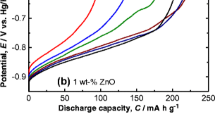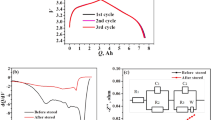Abstract
Nickel–metal hydride (Ni–MH) batteries using hydrogen storage alloys as negative electrode materials have been developed and commercialized because of their high energy density, high rate capability and long cycle life, without causing environmental pollution (Song et al. J Alloys Comp 298:254, 2000; Jang et al. J Alloys Comp 268:290, 1998). However, the self-discharge rate is relatively higher than that of the Ni–Cd batteries, which would certainly be disadvantageous in practical applications. The capacity loss of a battery during storage is often related to self-discharge in the cells. Self-discharge takes place from a highly charged state of a cell to a lower state of charge (SOC) and is typically caused by the highly oxidizing or reducing characteristic of one or both of the electrodes in the cell. This self-discharge behavior may be affected by various factors such as gases, impurities, temperature, type of alloy electrode, electrolytes, or charge/discharge methods. The loss of capacity can be permanent or recoverable, depending on the nature of the mechanism (chemical or electrochemical) and aging condition.
In this paper, the effects of electrolyte composition and temperature on self-discharge behavior of LaNi5-based hydrogen storage alloy electrodes for Ni–MH batteries have been investigated. It was found that both reversible and irreversible capacity loss of MH electrode tested at 333 K were higher than that at 298 K. When tested at 298 K and 333 K, reversible capacity loss was mainly affected by the electrolyte, while the irreversible capacity loss was not affected. The dissolution of Al from the electrode can be reduced more effectively in an electrolyte with Al addition, compared with that in normal electrolyte. This resulted in a lower reversible capacity loss for the electrode exposed in the Al3+-rich electrolyte. SEM analysis has shown that some needle shape and hexagonal corrosion products were formed on the surface of the alloy electrodes, especially after storage at high temperature.








Similar content being viewed by others
References
Song MY, Ahn D, Kwon IH, Lee R, Rim H (2000) J Alloys Comp 298:254
Jang KJ, Jung JH, Kim DM, Yu JS, Lee JY (1998) J Alloys Comp 268:290
Iwakura C, Kajiya Y, Yoneyama H, Sakai T, Oguro K, Ishikawa H (1989) J Electrochem Soc 136:1351
Mao Z, Visintin A, Srinivasan S, Appleby AJ, Lim HS (1999) J Appl Electrochem 22:409
Yang XG, Liaw BY (2004) J Electrochem Soc 151:A137
Vassal N, Salmon E, Fauvarque JF (1999) J Electrochem Soc 146:20
Feng F, Northwood DO (2005) Int J Hydrogen Energy 30:1367
Wang CS, Marrero-Rivera M, Serafini DA, Baricuatro JH, Soriaga MP, Srinivasan S (2006) Int J Hydrogen Energy 31:603
Xia B, Shi P, Yin G, Zhou D (1999) J Alloys Comp 293:737
Weng WX (2003) Thesis (Masters), National Taiwan University, Taiwan
Maurel F, Knosp B, Backhaus-Ricoult M (2000) J Electrochem Soc 147:78
Author information
Authors and Affiliations
Corresponding author
Additional information
Contribution to ICMAT 2007, Symposium K: Nanostructured and bulk materials for electrochemical power sources, July 1–6, 2007, Singapore.
Rights and permissions
About this article
Cite this article
Li, C.Y.V., Weng, WX., Wang, ZM. et al. Self-discharge behavior of LaNi5-based hydrogen storage electrodes in different electrolytes. J Solid State Electrochem 12, 935–940 (2008). https://doi.org/10.1007/s10008-008-0517-3
Received:
Revised:
Accepted:
Published:
Issue Date:
DOI: https://doi.org/10.1007/s10008-008-0517-3




